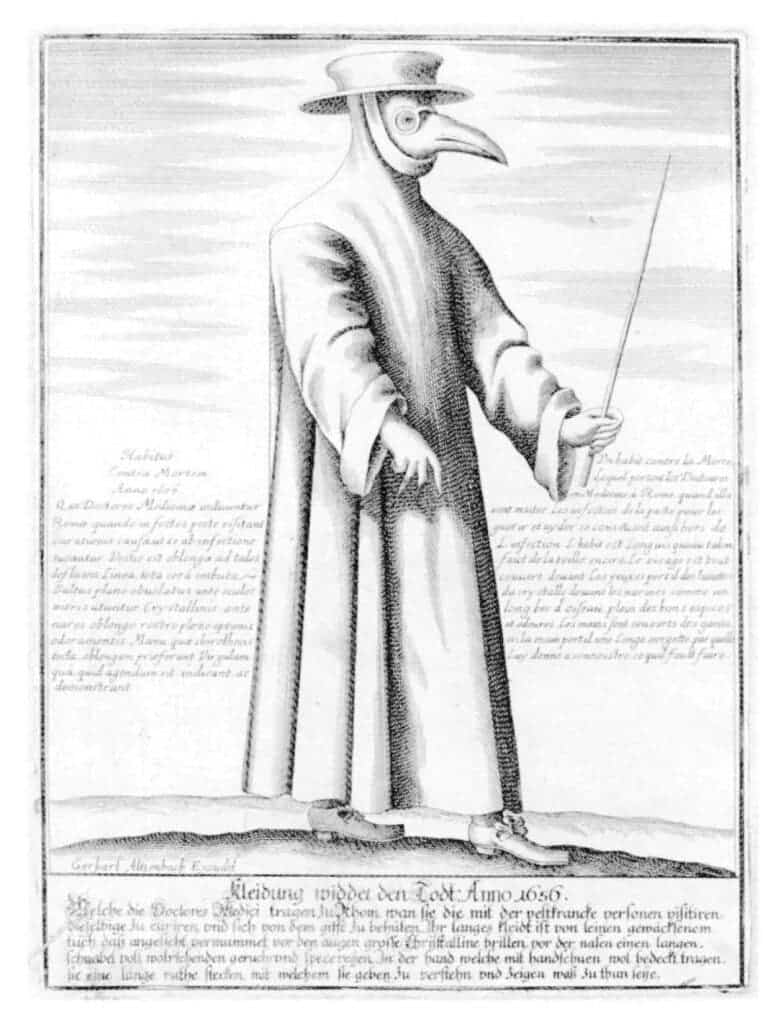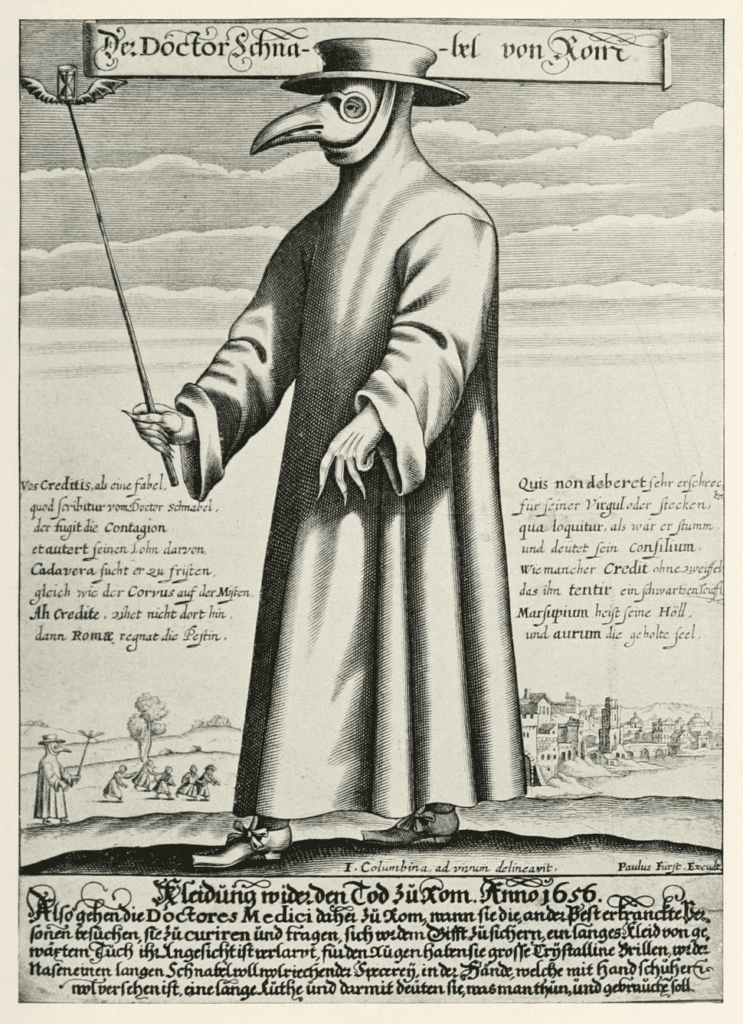Respirology | APSR Respiratory Medicine Journal


The COVID-19 pandemic has become one of the worst health crises in a century, with over five million killed so far by the coronavirus. But, let's face it: we've seen much worse. The Black Death, for instance, loomed like a specter of pestilence for centuries, rapidly spreading, then subsiding, only to return in yet another wave. At one point, the plague killed one-third of Europe's population in only a few years.
In Medieval times, you knew things were serious when the plague doctor came to town, who was immediately recognizable by his beaked mask. If you thought hazmat suits were scary, the costumes worn by these plague doctors elicited a whole new level of dread mixed with mystery, the kind that would be at home in a David Lynch film.
Although the Black Plague reached Sicilian ports in the late 1340s, the plague doctors didn't start wearing their now-iconic fashion until the 17th century. The design of the costume is credited to Charles de Lorme, the personal physician of King Louis XIII of France and the wealthy Médici family. It is believed that de Lorme introduced the uniform in 1619.
The outfit consisted of a long coat that was covered in scented wax, which extended all the way down to the ankle where the feet were dressed in boots made of goat leather. Underneath the coat, the plague doctor wore a short-sleeved blouse that was tucked-in, as well as gloves and a hat made of the same goat leather. But the most defining feature of the outfit is definitely the long-beaked mask that was stuffed with powerfully scented herbs and spices. Finally, the costume was completed by a pair of round glass spectacles tethered by leather bands that also kept the mask tightly to the doctor's head. A long wooden stick was also part of the look, which the plague doctor used to examine patients but also to ward off desperate and dangerous plague-stricken people.
In order to understand the motivations behind designing such a peculiar uniform, we need some context. The consensus among the most educated physicians of those times was that the plague, like many other epidemics, was caused by miasma — a noxious bad air. Sweet and pungent odors were thought to cancel out the miasma in plague-stricken areas and protect from disease. Nosegays, incense, and other perfumes were sprayed furiously when plague knocked on the door.

The first illustration of a plague doctor's uniform, completed by Gerhart Altzenbach in the mid-1600s, not only features the entire costume but also provides explanations for how each part was intended to protect the wearer from the plague. The six-inch beak worn by the plague doctors was supposed to act as a face mask that filters out the bad air. It was designed so long in order to accommodate herbs enclosed further along in the beak, with only two small holes for ventilation. Many times, the herbs — typically a mixture of more than 50 plants and flavors like cinnamon, myrrh, viper flesh powder, and honey — were burned before the doctor put on his mask.
However, since the uniform was supposed to be worn tightly over the entire body and not leave the skin exposed, the physicians were at least somewhat aware that the plague was spread by close proximity to the infected.
Unfortunately for both plague doctors and their patients, the uniform wasn't very effective and mostly served to terrorize people.
They couldn't have known it at the time, but the plague is actually caused by a species of bacteria called Yersinia pestis, which is transmitted from animals like rats to humans through flea bites. You could also catch the plague easily if you came in contact with contaminated fluid or tissue or inhaled droplets from sneezing or coughing patients that had pneumonic plague. So perhaps the costume offered some degree of protection, but without any proper protocols for hygiene and disinfection, the protection was likely marginal at best.
Not only was their outfit ineffective at combating the plague, so were the plague doctors' strategies — even by the standards of the time.
Some of the "cures" in a plague doctors' medicine purpose include onions, herbs, and even chopped up snakes that would be rubbed on the boils of the patient. Sometimes a pigeon may have been sacrificed, whose bloody carcass is then rubbed all over the infected body. Others covered blisters with human excrement.
Since the miasma theory was in fashion, almost every house call involved fumigating the house with herbs to purify the air. If the proper odors were not available, people were advised to sit by a fire or even a sewer to drive out the smell of fever.
Baths were also prescribed but not in the most hygienic conditions. Bathing should be done with vinegar and rosewater, alternatively in your own urine.
But the worst procedure was bursting the buboes — painful lymph nodes that form in the armpits, upper femoral, groin, and neck region of individuals infected with the plague — which did nothing to aid the patient. Bloodletting was a common (and highly ineffective) medical procedure during those times employed against a wide range of illnesses, but opening the festering blisters only helped to further spread the infection to other people. Some patients were even told to drink the pus of lanced buboes.

The ineffectiveness of plague doctors and their wacky costumes did not go unnoticed by their contemporaries. In the same year that the first illustration of a plague doctor costume was released, another engraver by the name Paulus Fürst released a satirical version in which he referred to the plague doctors as 'Doctor Schnabel von Rom.' ('Doctor Beaky from Rome'). In one of the sentences on the engraving, Fürst alluded that the doctor 'does nothing but terrify people and take money from the dead and dying.'
Indeed the plague doctors weren't even actual physicians most of the time. Instead, they were usually unqualified, poor individuals who didn't have much to lose when they were hired by municipalities to treat plague patients. As you might imagine, competent and successful doctors weren't too keen on taking the job, which saw many plague doctors die on the job. Of the 18 plague doctors who worked in Venice at one time during the 14th century, five died and 12 fled.
Not all plague doctors were motivated by good intentions either. A plague doctor was not only tasked with treating and quarantining the ill, but also had responsibilities when it came to assisting in the occasional autopsy or witnessing the wills of the dead and dying. This gave them a lot of power and it was not uncommon for a plague doctor to take advantage of his position and run off with a patient's finances and objects of worth.
Before COVID-19, the plague doctors were seen as an oddity of history and a great character to go out as during Halloween. But the harsh reality of the pandemic is perhaps making us more sympathetic with these first responders who risked their lives during highly uncertain times. And although most of their medical interventions were not based on science and did more harm than good, the plague doctors were on to something with their head-to-toe uniform. Today, we know for a fact that hazmat suits and even surgical masks can greatly diminish one's risk of contracting an infectious disease. If it took a very sinister suit to kick things off for personal protective equipment, we should be grateful for having plague doctors, I guess.
Comments
Post a Comment